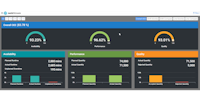What Is OEE Software?
OEE Software Helps Manufacturers Become More Profitable by Measuring Availability, Performance, and quality
OEE is an abbreviation for Overall Equipment Effectiveness and is an essential metric for manufacturing facilities. When measured consistently and correctly, it can boost productivity and enhance quality to accelerate overall operations (even when remote) and improve bottom-line results. Yet, despite its remarkable potential, OEE remains under-leveraged in manufacturing – largely because most facilities lack the tools and resources to measure it effectively. Fortunately, OEE software solves that problem.
In the world of manufacturing, OEE tells an important story about how Operations is running compared to its full potential. Until recently, most manufacturers have been unable to access that story, but forward-thinking companies have now begun implementing seamless OEE solutions to analyze what’s truly happening in their facilities with more detail than ever before.
With these solutions, manufacturers get a comprehensive look into their OEE score, both across their entire facility and by line, shift, or other key attributes. This OEE score allows companies to determine how much of their manufacturing time is actually productive, compared to a set standard. The calculation for OEE incorporates quality, performance, and availability.
Quality assesses the products which do not meet your facility’s quality standards and therefore encompasses quality loss. Examples of quality loss could include products requiring rework, as well as scrap. After time spent on quality loss has been accounted for in the OEE calculation, the remaining time represents the potential for fully productive time.
Performance assesses the factors which cause production to run below optimal speed. Problems such as machinery malfunctions and jams can cause performance loss. Once this figure is subtracted, it leaves you with net run time.
Availability assesses interruptions through availability loss, which halts production for a measurable length of time (a few minutes, typically). Availability loss could encompass changeover time, equipment malfunctions, and any other reason why production is temporarily stopped. With availability loss subtracted, you’re left with run time. It’s easy to see how even small changes in quality, performance or availability can radically affect yield and profitability. This is why OEE is such an important metric for manufacturers to measure.
OEE also accounts for scheduled loss and therefore excludes time dedicated to plant shutdowns and planned breaks. Thus, when OEE is calculated, it looks exclusively at planned production time.
A score of 100% would therefore mean that:
only good products are being produced (100% quality),
machinery and operations are running at the maximum speed (100% performance), and
there are no interruptions (100% availability).
As you might imagine, an OEE of 100% is virtually unattainable in manufacturing environments – especially in the food industry, where some degree of waste is usually inevitable.
Yet, that doesn’t mean that striving for the highest possible OEE isn’t possible. In fact, the objective of tracking this metric is not simply to measure how well you’re doing, but to push quality, performance, and availability to the maximum values you expect to achieve against your declared standard.
How Production OEE Software Helps Your Manufacturing Plant Excel
To boost production, most manufacturers use OEE for both benchmarking purposes and as a baseline.
As a benchmark, OEE acts as a basis for comparison, allowing manufacturers to track their actual operations against industry standards, other key thresholds, or even against themselves. For instance, you might compare the performance of one product line to another, or analyze the OEE of your early shift to a later one.
When used as a baseline, OEE helps companies detect and track deviances caused by improvements and problem areas, allowing managers to make key decisions and strive for outcomes such as increased quality, throughput, and manufacturing yield.
What is an OEE Software Solution?
Tracking OEE is challenging – if not impossible – to do manually. While many machines and types of manufacturing equipment provide key metrics which workers can collect and analyze, the process of keying-in equipment data and analyzing it is resource-intensive, and frankly, is not the best use of employees’ time.
As with many other tedious, time-consuming processes, technology can speed the collection of equipment data and make sense of it. Not only does this save time, but it also eliminates the risk of human error.
With the help of OEE software solutions, you can receive instant insights into key metrics such as:
Production trends
Planned production time
Downtime
Run time and net run time
Fully productive time
OEE software doesn’t just automate the collection of your equipment data, however. It also fully leverages your data as a key asset to help you improve daily production, applying advanced analytics to uncover key areas of opportunity.
Your equipment data holds a wealth of knowledge, but these valuable insights are nearly impossible to access without the right tools. With the help of advanced algorithms, OEE software extracts every bit of value from your data to uncover what could be going wrong in your operations. Moreover, with automated features such as notifications, you can receive real-time alerts on need-to-know issues, such as when pieces start to deviate from their normal standards.
What Sets The Top OEE Software Apart
As with any type of technology, not all OEE software is created equally. The top OEE software leverages IoT devices to measure productivity with the utmost level of accuracy ensuring your know when you are meeting your critical KPIs. It also works in real-time, allowing you to gain instant visibility into production at any given moment. Yet, it can also filter down and provide comparative analyses so you can track your most (and least) productive periods, lines, and shifts. With the ability to view historical trends, you can also uncover weak spots or problem areas that may need your attention.
The best OEE software also makes it simple to access all of these insights through compelling visuals and user-friendly dashboards. Even without technical expertise, line managers and business leaders alike can navigate the system with ease. The most important insights are visible immediately via crisp graphs and charts on beautiful dashboards, while other key data can be retrieved easily in just a few clicks.
OEE software does not have to be expensive. For insights into pricing, visit our blog, A Manufacturer's Guide to OEE Software price.
What OEE Calculation Software Can Tell You
There are dozens of previously untapped insights companies can access and leverage through OEE calculation software. Here are just a few of the most noteworthy metrics to consider:
Loss: Understanding your losses is integral to driving improvement. While most companies anticipate some degree of loss, they’re often surprised to discover the percentage of their resources which are being wasted.
There are a few key areas of loss to analyze:
Stops: In some form or another, planned stops are always necessary. For instance, a line that produces baked goods both with and without nuts would need to shut down operations for a short period of time to sanitize between cycles producing products with and without the allergen. Scheduled maintenance, setup time, and adjustments are also examples of planned stops.
Unplanned stops, on the other hand, often result from equipment failures and have the potential to derail productivity. With OEE software, you can track when unplanned stops occur and how long they last to make more strategic operational decisions. For instance, scheduling additional preventive maintenance could ultimately save time in the long run.
Performance Loss: Caused by minor stops, idling, and cycles that run below optimal speed, performance losses may only account for a minute or two of missed productivity. Yet, they can add up over time. Oftentimes, the root causes for these issues include improperly aligned equipment or sensors, jams, and obstructions. OEE software allows you to capture patterns in performance loss for faster and more accurate root cause analysis.
Rejects: Every food company experiences quality losses in the form of defective products and reduced yield. Minimizing the amount of rejected products or rework is critical to reducing waste and positively impacting the bottom line. OEE software helps you pinpoint where quality losses happen most frequently, allowing you to determine whether factors like equipment or operator errors could be behind these issues.
TEEP: While OEE accounts for quality, performance, and availability, TEEP (Total Effective Equipment Performance) takes that measurement a step further by introducing a fourth factor: utilization. Short for total effective equipment performance, TEEP is different from OEE in that it changes how you define availability. A TEEP calculation considers all available time in a literal sense (often 24 hours a day, 365 days per year). OEE, on the other hand, accounts for unscheduled time and considers total operational time as the maximum.
Although OEE is the industry standard, analyzing TEEP may help you understand how factors like scheduled breaks and shutdowns play a role in your manufacturing outcomes.
How The Best OEE Software Works For You
With the ability to spot gaps in your operations and address them promptly, OEE software helps manufacturers improve in the following ways.
Improved Productivity: Maximize the performance of your machinery and ensure all of your equipment is working at full capacity at all possible times. Improve workplace productivity by identifying shift and line trends and enhancing performance through targeted management practices.
Boosted Quality: Pinpoint the factors that could be leading to rejects, rework, and non-conformances and correct them as needed to ensure a consistent stream of higher-quality products.
Increased Throughput: Eliminate wasteful or redundant actions and the number of defective products with the help of the advanced analysis provided by OEE software data collection.
Greater Yield: Maximize the volume of finished products and maintain on-time deliveries to customers by taking strategic actions based on OEE insights.
Reduced Costs: Cut costs from underperformance, scrap, and limited productivity with leaner operations that improve your company’s bottom line.
With the insights gleaned from OEE software, improving these and other important manufacturing outcomes is made possible in your facility. Many manufacturers find analyses and reports delivered by OEE software to be eye-opening: even if you thought you were operating at peak capacity, there are many hidden ways you could be improving.
Allow us to help unlock the story behind your data with our leading OEE software designed exclusively with food and beverage companies in mind. Schedule a demo to see our solution in action and to begin exploring how our system could work to meet your facility’s greatest challenges.



